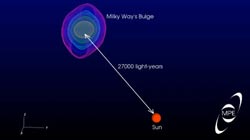The inside of our Milky Way in 3D

Three-dimensional map of Milky Way's bulge, calculated from observations of red clump giant stars. This is the first time that such an accurate 3D-map has been reconstructed of the inner regions of our Milky Way. Because the map is 3D it can be rotated and viewed from different directions or detailed slices examined as shown in the video. The sun is shown in relation to the map but is not to scale.<br>
They find a box/peanut shaped bulge with an elongated bar and a prominent X-structure, which had been hinted at in previous studies. This indicates that the Milky Way was originally a pure disk of stars, which then formed a thin bar, before buckling into the box/peanut shape seen today.
The new map can be used for more detailed studies of the dynamics and evolution of our Milky Way.
Our Sun resides right inside the galactic disk, about 27 000 light-years from the core of our Milky Way. Due to the obscuring effects of dense gas and dust clouds it is therefore difficult to get accurate information about the shape and properties of the inner regions of our galaxy. By using a large number of so-called “red clump” giant stars from the new VVV survey scientists at the Max Planck Institute for Extraterrestrial Physics have now produced a three-dimensional map of the galactic bulge.
“While several studies with red clump giants and other methods have found evidence for a triaxial structure of the galactic bulge, the depth of this star catalogue exceeds previous work and we can detect the entire population of red clump giants in all but the most highly obscured regions,” explains Christopher Wegg at MPE. “From this star distribution we can then directly infer the three-dimensional density map, without the need to compare to theoretical models.”
The scientists used the VVV near-infrared survey of the bulge conducted with the VISTA telescope in Chile (“VISTA Variables in the Via Lactea Survey”), which covers the inner regions of the Milky Way and is able to observe stars thirty times fainter than previous bulge surveys. The observations were carried out by the VVV team, who then made their images and star catalogues available to the international community as science data products in the ESO science archive facility.
Red clump giant stars were chosen for this study as they can be used as a standard candle: at this stage in the star’s lifetime their luminosity is approximately independent of their age or composition. The amount of gas and dust obscuring the stars is calculated directly from the observed colours of the red clump stars, so that their brightness distribution without obscuration can be measured. Because red clump stars have nearly the same intrinsic brightness, this gives approximate distances to each star. The good spatial coverage of the VVV survey allowed measurements across the whole inner region of the Milky Way, and from these the three-dimensional measurement of the structure of the bulge was constructed.
“In our analysis we find that the inner region of our galaxy is in the shape of a box/peanut, with a highly elongated bar and a prominent X-structure,” says Ortwin Gerhard, who leads the dynamics group at MPE. “It is the first time that we can see this clearly in our own Milky Way, and the simulations in our group show that this shape is fairly characteristic of a barred spiral galaxy.” In these simulations performed by Inma Martinez-Valpuesta, the Milky Way was a pure disk of stars which formed a flat bar billions of years ago before the inner part of this then buckled to form the three-dimensional box/peanut shape seen in the map.
The scientists expect that this measurement of the three-dimensional density of the bulge will help to constrain galaxy evolution models for both our Milky Way and spiral galaxies in general. But will also support a number of further studies on different stellar populations, gas flows, or microlensing.
Dr. Hannelore Hämmerle
MPE Pressesprecherin
Phone:+49 (0)89 30000 3980
Fax:+49 (0)89 30000 3569
Max-Planck-Institut für extraterrestrische Physik, Garching
Dr. Ortwin Gerhard
Phone:+49 89 30000 3539
Fax:+49 89 30000 3569
Wegg, Christopher
postdoc
Phone: +49 (0)89 30000-3715
Fax: +49 (0)89 30000-3569
Original publication
Christopher Wegg, Ortwin Gerhard
Mapping the three-dimensional density of the Galactic bulge with VVV red clump stars
MNRAS 2013
Media Contact
More Information:
http://www.mpe.mpg.de/3286155/News_20130912All latest news from the category: Physics and Astronomy
This area deals with the fundamental laws and building blocks of nature and how they interact, the properties and the behavior of matter, and research into space and time and their structures.
innovations-report provides in-depth reports and articles on subjects such as astrophysics, laser technologies, nuclear, quantum, particle and solid-state physics, nanotechnologies, planetary research and findings (Mars, Venus) and developments related to the Hubble Telescope.
Newest articles

Properties of new materials for microchips
… can now be measured well. Reseachers of Delft University of Technology demonstrated measuring performance properties of ultrathin silicon membranes. Making ever smaller and more powerful chips requires new ultrathin…

Floating solar’s potential
… to support sustainable development by addressing climate, water, and energy goals holistically. A new study published this week in Nature Energy raises the potential for floating solar photovoltaics (FPV)…

Skyrmions move at record speeds
… a step towards the computing of the future. An international research team led by scientists from the CNRS1 has discovered that the magnetic nanobubbles2 known as skyrmions can be…





















